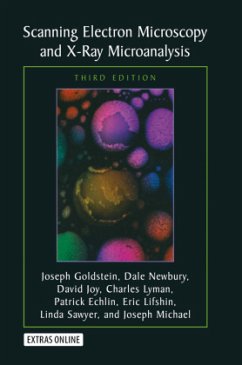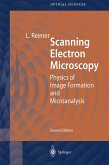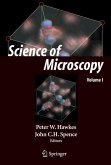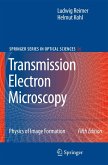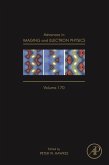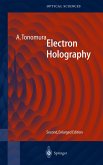Joseph Goldstein, Dale E. Newbury, David C. JoyThird Edition
Scanning Electron Microscopy and X-Ray Microanalysis
Third Edition
Mitwirkender: Joy, David C.; Newbury, Dale E.
Joseph Goldstein, Dale E. Newbury, David C. JoyThird Edition
Scanning Electron Microscopy and X-Ray Microanalysis
Third Edition
Mitwirkender: Joy, David C.; Newbury, Dale E.
- Gebundenes Buch
- Merkliste
- Auf die Merkliste
- Bewerten Bewerten
- Teilen
- Produkt teilen
- Produkterinnerung
- Produkterinnerung
- Weitere 6 Ausgaben:
- Broschiertes Buch
- Broschiertes Buch
- Broschiertes Buch
- eBook, PDF
- eBook, PDF
- eBook, PDF
An ideal text for students as well as practitioners, this is a comprehensive introduction to the field of scanning electron microscopy (SEM) and X-ray microanalysis. The authors emphasize the practical aspects of the techniques described.
In the decade since the publication of the second edition of Scanning Electron Microscopy and X-Ray Microanalysis, there has been a great expansion in the capabilities of the basic scanning electron microscope (SEM) and the x-ray spectrometers. The emergence of the variab- pressure/environmental SEM has enabled the observation of samples c- taining water…mehr
Andere Kunden interessierten sich auch für
![Scanning Electron Microscopy Scanning Electron Microscopy]() Ludwig ReimerScanning Electron Microscopy353,09 €
Ludwig ReimerScanning Electron Microscopy353,09 €![Science of Microscopy Science of Microscopy]() P.W. Hawkes / John C. H. Spence (eds.)Science of Microscopy373,99 €
P.W. Hawkes / John C. H. Spence (eds.)Science of Microscopy373,99 €![Transmission Electron Microscopy Transmission Electron Microscopy]() Ludwig ReimerTransmission Electron Microscopy188,99 €
Ludwig ReimerTransmission Electron Microscopy188,99 €![Advances in Imaging and Electron Physics Advances in Imaging and Electron Physics]() Advances in Imaging and Electron Physics166,99 €
Advances in Imaging and Electron Physics166,99 €![Advances in Imaging and Electron Physics Advances in Imaging and Electron Physics]() Advances in Imaging and Electron Physics139,99 €
Advances in Imaging and Electron Physics139,99 €![Electron Holography Electron Holography]() Akira TonomuraElectron Holography77,99 €
Akira TonomuraElectron Holography77,99 €![Self-Assembled Nanostructures Self-Assembled Nanostructures]() Jin ZhangSelf-Assembled Nanostructures77,99 €
Jin ZhangSelf-Assembled Nanostructures77,99 €-
-
-
An ideal text for students as well as practitioners, this is a comprehensive introduction to the field of scanning electron microscopy (SEM) and X-ray microanalysis. The authors emphasize the practical aspects of the techniques described.
In the decade since the publication of the second edition of Scanning Electron Microscopy and X-Ray Microanalysis, there has been a great expansion in the capabilities of the basic scanning electron microscope (SEM) and the x-ray spectrometers. The emergence of the variab- pressure/environmental SEM has enabled the observation of samples c- taining water or other liquids or vapor and has allowed for an entirely new class of dynamic experiments, that of direct observation of che- cal reactions in situ. Critical advances in electron detector technology and computer-aided analysis have enabled structural (crystallographic) analysis of specimens at the micrometer scale through electron backscatter diffr- tion (EBSD). Low-voltage operation below 5 kV has improved x-ray spatial resolution by more than an order of magnitude and provided an effective route to minimizing sample charging. High-resolution imaging has cont- ued to develop with a more thorough understanding of how secondary el- trons are generated. The ?eld emission gun SEM, with its high brightness, advanced electron optics, which minimizes lens aberrations to yield an - fective nanometer-scale beam, and "through-the-lens" detector to enhance the measurement of primary-beam-excited secondary electrons, has made high-resolution imaging the rule rather than the exception. Methods of x-ray analysis have evolved allowing for better measurement of specimens with complex morphology: multiple thin layers of different compositions, and rough specimens and particles. Digital mapping has transformed classic x-ray area scanning, a purely qualitative technique, into fully quantitative compositional mapping.
In the decade since the publication of the second edition of Scanning Electron Microscopy and X-Ray Microanalysis, there has been a great expansion in the capabilities of the basic scanning electron microscope (SEM) and the x-ray spectrometers. The emergence of the variab- pressure/environmental SEM has enabled the observation of samples c- taining water or other liquids or vapor and has allowed for an entirely new class of dynamic experiments, that of direct observation of che- cal reactions in situ. Critical advances in electron detector technology and computer-aided analysis have enabled structural (crystallographic) analysis of specimens at the micrometer scale through electron backscatter diffr- tion (EBSD). Low-voltage operation below 5 kV has improved x-ray spatial resolution by more than an order of magnitude and provided an effective route to minimizing sample charging. High-resolution imaging has cont- ued to develop with a more thorough understanding of how secondary el- trons are generated. The ?eld emission gun SEM, with its high brightness, advanced electron optics, which minimizes lens aberrations to yield an - fective nanometer-scale beam, and "through-the-lens" detector to enhance the measurement of primary-beam-excited secondary electrons, has made high-resolution imaging the rule rather than the exception. Methods of x-ray analysis have evolved allowing for better measurement of specimens with complex morphology: multiple thin layers of different compositions, and rough specimens and particles. Digital mapping has transformed classic x-ray area scanning, a purely qualitative technique, into fully quantitative compositional mapping.
Produktdetails
- Produktdetails
- Verlag: Springer / Springer Netherlands / Springer US
- Artikelnr. des Verlages: 11127857, 978-0-306-47292-3
- 3rd ed.
- Seitenzahl: 689
- Erscheinungstermin: 31. Januar 2003
- Englisch
- Abmessung: 263mm x 187mm x 34mm
- Gewicht: 1619g
- ISBN-13: 9780306472923
- ISBN-10: 0306472929
- Artikelnr.: 14050443
- Herstellerkennzeichnung
- Libri GmbH
- Europaallee 1
- 36244 Bad Hersfeld
- gpsr@libri.de
- Verlag: Springer / Springer Netherlands / Springer US
- Artikelnr. des Verlages: 11127857, 978-0-306-47292-3
- 3rd ed.
- Seitenzahl: 689
- Erscheinungstermin: 31. Januar 2003
- Englisch
- Abmessung: 263mm x 187mm x 34mm
- Gewicht: 1619g
- ISBN-13: 9780306472923
- ISBN-10: 0306472929
- Artikelnr.: 14050443
- Herstellerkennzeichnung
- Libri GmbH
- Europaallee 1
- 36244 Bad Hersfeld
- gpsr@libri.de
Joseph Goldstein, University of Massachusetts, Amherst, MA, USA / Dale E. Newbury, National Institute of Standards and Technology, Gaithersburg, MD, USA / David C. Joy, University of Tennessee, Knoxville, TN, USA / Charles E. Lyman, Lehigh University, Bethlehem, PA, USA / Patrick Echlin, University of Cambridge, UK / Eric Lifshin, State University at Albany, NY, USA / L.C. Sawyer, Ticona LLC, Summit, NJ, USA / J.R. Michael, Sandia National Laboratories, Albuquerque, NM, USA
1. Introduction.- 1.1. Imaging Capabilities.- 1.2. Structure Analysis.- 1.3. Elemental Analysis.- 1.4. Summary and Outline of This Book.- Appendix A. Overview of Scanning Electron Microscopy.- Appendix B. Overview of Electron Probe X-Ray Microanalysis.- References.- 2. The SEM and Its Modes of Operation.- 2.1. How the SEM Works.- 2.1.1. Functions of the SEM Subsystems.- 2.1.1.1. Electron Gun and Lenses Produce a Small Electron Beam.- 2.1.1.2. Deflection System Controls Magnification.- 2.1.1.3. Electron Detector Collects the Signal.- 2.1.1.4. Camera or Computer Records the Image.- 2.1.1.5. Operator Controls.- 2.1.2. SEM Imaging Modes.- 2.1.2.1. Resolution Mode.- 2.1.2.2. High-Current Mode.- 2.1.2.3. Depth-of-Focus Mode.- 2.1.2.4. Low-Voltage Mode.- 2.1.3. Why Learn about Electron Optics?.- 2.2. Electron Guns.- 2.2.1. Tungsten Hairpin Electron Guns.- 2.2.1.1. Filament.- 2.2.1.2. Grid Cap.- 2.2.1.3. Anode.- 2.2.1.4. Emission Current and Beam Current.- 2.2.1.5. Operator Control of the Electron Gun.- 2.2.2. Electron Gun Characteristics.- 2.2.2.1. Electron Emission Current.- 2.2.2.2. Brightness.- 2.2.2.3. Lifetime.- 2.2.2.4. Source Size, Energy Spread, Beam Stability.- 2.2.2.5. Improved Electron Gun Characteristics.- 2.2.3. Lanthanum Hexaboride (LaB6) Electron Guns.- 2.2.3.1. Introduction.- 2.2.3.2. Operation of the LaB6 Source.- 2.2.4. Field Emission Electron Guns.- 2.3. Electron Lenses.- 2.3.1. Making the Beam Smaller.- 2.3.1.1. Electron Focusing.- 2.3.1.2. Demagnification of the Beam.- 2.3.2. Lenses in SEMs.- 2.3.2.1. Condenser Lenses.- 2.3.2.2. Objective Lenses.- 2.3.2.3. Real and Virtual Objective Apertures.- 2.3.3. Operator Control of SEM Lenses.- 2.3.3.1. Effect of Aperture Size.- 2.3.3.2. Effect of Working Distance.- 2.3.3.3. Effect of Condenser Lens Strength.- 2.3.4. Gaussian Probe Diameter.- 2.3.5. Lens Aberrations.- 2.3.5.1. Spherical Aberration.- 2.3.5.2. Aperture Diffraction.- 2.3.5.3. Chromatic Aberration.- 2.3.5.4. Astigmatism.- 2.3.5.5. Aberrations in theObjective Lens.- 2.4. Electron Probe Diameter versus Electron Probe Current.- 2.4.1. Calculation of dmin and imax.- 2.4.1.1. Minimum Probe Size.- 2.4.1.2. Minimum Probe Size at 10-30 kV.- 2.4.1.3. Maximum Probe Current at 10-30 kV.- 2.4.1.4. Low-Voltage Operation.- 2.4.1.5. Graphical Summary.- 2.4.2. Performance in the SEM Modes.- 2.4.2.1. Resolution Mode.- 2.4.2.2. High-Current Mode.- 2.4.2.3. Depth-of-Focus Mode.- 2.4.2.4. Low-Voltage SEM.- 2.4.2.5. Environmental Barriers to High-Resolution Imaging.- References.- 3. Electron Beam-Specimen Interactions.- 3.1. The Story So Far.- 3.2. The Beam Enters the Specimen.- 3.3. The Interaction Volume.- 3.3.1. Visualizing the Interaction Volume.- 3.3.2. Simulating the Interaction Volume.- 3.3.3. Influence of Beam and Specimen Parameters on the Interaction Volume.- 3.3.3.1. Influence of Beam Energy on the Interaction Volume.- 3.3.3.2. Influence of Atomic Number on the Interaction Volume.- 3.3.3.3. Influence of Specimen Surface Tilt on the Interaction Volume.- 3.3.4. Electron Range: A Simple Measure of the Interaction Volume.- 3.3.4.1. Introduction.- 3.3.4.2. The Electron Range at Low Beam Energy.- 3.4. Imaging Signals from the Interaction Volume.- 3.4.1. Backscattered Electrons.- 3.4.1.1. Atomic Number Dependence of BSE.- 3.4.1.2. Beam Energy Dependence of BSE.- 3.4.1.3. Tilt Dependence of BSE.- 3.4.1.4. Angular Distribution of BSE.- 3.4.1.5. Energy Distribution of BSE.- 3.4.1.6. Lateral Spatial Distribution of BSE.- 3.4.1.7. Sampling Depth of BSE.- 3.4.2. Secondary Electrons.- 3.4.2.1. Definition and Origin of SE.- 3.4.2.2. SE Yield with Primary Beam Energy.- 3.4.2.3. SE Energy Distribution.- 3.4.2.4. Range and Escape Depth of SE.- 3.4.2.5. Relative Contributions of SE1 and SE2.- 3.4.2.6. Specimen Composition Dependence of SE.- 3.4.2.7. Specimen Tilt Dependence of SE.- 3.4.2.8. Angular Distribution of SE.- References.- 4. Image Formation and Interpretation.- 4.1. The Story So Far.- 4.2. The Basic SEM Imaging Process.- 4.2.1.Scanning Action.- 4.2.2. Image Construction (Mapping).- 4.2.2.1. Line Scans.- 4.2.2.2. Image (Area) Scanning.- 4.2.2.3. Digital Imaging: Collection and Display.- 4.2.3. Magnification.- 4.2.4. Picture Element (Pixel) Size.- 4.2.5. Low-Magnification Operation.- 4.2.6. Depth of Field (Focus).- 4.2.7. Image Distortion.- 4.2.7.1. Projection Distortion: Gnomonic Projection.- 4.2.7.2. Projection Distortion: Image Foreshortening.- 4.2.7.3. Scan Distortion: Pathological Defects.- 4.2.7.4. Moiré Effects.- 4.3. Detectors.- 4.3.1. Introduction.- 4.3.2. Electron Detectors.- 4.3.2.1. Everhart-Thornley Detector.- 4.3.2.2. "Through-the-Lens" (TTL) Detector.- 4.3.2.3. Dedicated Backscattered Electron Detectors.- 4.4. The Roles of the Specimen and Detector in Contrast Formation.- 4.4.1. Contrast.- 4.4.2. Compositional (Atomic Number) Contrast.- 4.4.2.1. Introduction.- 4.4.2.2. Compositional Contrast with Backscattered Electrons.- 4.4.3. Topographic Contrast.- 4.4.3.1. Origins of Topographic Contrast.- 4.4.3.2. Topographic Contrast with the Everhart-Thornley Detector.- 4.4.3.3. Light-Optical Analogy.- 4.4.3.4. Interpreting Topographic Contrast with Other Detectors.- 4.5. Image Quality.- 4.6. Image Processing for the Display of Contrast Information.- 4.6.1. The Signal Chain.- 4.6.2. The Visibility Problem.- 4.6.3. Analog and Digital Image Processing.- 4.6.4. Basic Digital Image Processing.- 4.6.4.1. Digital Image Enhancement.- 4.6.4.2. Digital Image Measurements.- References.- 5. Special Topics in Scanning Electron Microscopy.- 5.1. High-Resolution Imaging.- 5.1.1. The Resolution Problem.- 5.1.2. Achieving High Resolution at High Beam Energy.- 5.1.3. High-Resolution Imaging at Low Voltage.- 5.2. STEM-in-SEM: High Resolution for the Special Case of Thin Specimens.- 5.3. Surface Imaging at Low Voltage.- 5.4. Making Dimensional Measurements in the SEM.- 5.5. Recovering the Third Dimension: Stereomicroscopy.- 5.5.1. Qualitative Stereo Imaging and Presentation.- 5.5.2. Quantitative Stereo Microscopy.- 5.6. Variable-Pressure and Environmental SEM.- 5.6.1. Current Instruments.- 5.6.2. Gas in the Specimen Chamber.- 5.6.2.1. Units of Gas Pressure.- 5.6.2.2. The Vacuum System.- 5.6.3. Electron Interactions with Gases.- 5.6.4. The Effect of the Gas on Charging.- 5.6.5. Imaging in the ESEM and the VPSEM.- 5.6.6. X-Ray Microanalysis in the Presence of a Gas.- 5.7. Special Contrast Mechanisms.- 5.7.1. Electric Fields.- 5.7.2. Magnetic Fields.- 5.7.2.1. Type 1 Magnetic Contrast.- 5.7.2.2. Type 2 Magnetic Contrast.- 5.7.3. Crystallographic Contrast.- 5.8. Electron Backscatter Patterns.- 5.8.1. Origin of EBSD Patterns.- 5.8.2. Hardware for EBSD.- 5.8.3. Resolution of EBSD.- 5.8.3.1. Lateral Spatial Resolution.- 5.8.3.2. Depth Resolution.- 5.8.4. Applications.- 5.8.4.1. Orientation Mapping.- 5.8.4.2. Phase Identification.- References.- 6. Generation of X-Rays in the SEM Specimen.- 6.1. Continuum X-Ray Production (Bremsstrahlung).- 6.2. Characteristic X-Ray Production.- 6.2.1. Origin.- 6.2.2. Fluorescence Yield.- 6.2.3. Electron Shells.- 6.2.4. Energy-Level Diagram.- 6.2.5. Electron Transitions.- 6.2.6. Critical Ionization Energy.- 6.2.7. Moseley's Law.- 6.2.8. Families of Characteristic Lines.- 6.2.9. Natural Width of Characteristic X-Ray Lines.- 6.2.10. Weights of Lines.- 6.2.11. Cross Section for Inner Shell Ionization.- 6.2.12. X-Ray Production in Thin Foils.- 6.2.13. X-Ray Production in Thick Targets.- 6.2.14. X-Ray Peak-to-Background Ratio.- 6.3. Depth of X-Ray Production (X-Ray Range).- 6.3.1. Anderson-Hasler X-Ray Range.- 6.3.2. X-Ray Spatial Resolution.- 6.3.3. Sampling Volume and Specimen Homogeneity.- 6.3.4.Depth Distribution of X-Ray Production, ?(?z).- 6.4. X-Ray Absorption.- 6.4.1. Mass Absorption Coefficient for an Element.- 6.4.2. Effect of Absorption Edge on Spectrum.- 6.4.3. Absorption Coefficient for Mixed-Element Absorbers.- 6.5. X-Ray Fluorescence.- 6.5.1. Characteristic Fluorescence.- 6.5.2. Continuum Fluorescence.- 6.5.3. Range of Fluorescence Radiation.- References.- 7. X-Ray Spectral Measurement: EDS and WDS.- 7.1. Introduction.- 7.2. Energy-Dispersive X-Ray Spectrometer.- 7.2.1. Operating Principles.- 7.2.2. The Detection Process.- 7.2.3. Charge-to-Voltage Conversion.- 7.2.4. Pulse-Shaping Linear Amplifier and Pileup Rejection Circuitry.- 7.2.5. The Computer X-Ray Analyzer.- 7.2.6. Digital Pulse Processing.- 7.2.7. Spectral Modification Resulting from the Detection Process.- 7.2.7.1. Peak Broadening.- 7.2.7.2. Peak Distortion.- 7.2.7.3. Silicon X-Ray Escape Peaks.- 7.2.7.4. Absorption Edges.- 7.2.7.5. Silicon Internal Fluorescence Peak.- 7.2.8. Artifacts from the Detector Environment.- 7.2.9. Summary of EDS Operation and Artifacts.- 7.3. Wavelength-Dispersive Spectrometer.- 7.3.1. Introduction.- 7.3.2. Basic Description.- 7.3.3. Diffraction Conditions.- 7.3.4. Diffracting Crystals.- 7.3.5. The X-Ray Proportional Counter.- 7.3.6. Detector Electronics.- 7.4. Comparison of Wavelength-Dispersive Spectrometers with Conventional Energy-Dispersive Spectrometers.- 7.4.1. Geometric Collection Efficiency.- 7.4.2. Quantum Efficiency.- 7.4.3. Resolution.- 7.4.4. Spectral Acceptance Range.- 7.4.5. Maximum Count Rate.- 7.4.6. Minimum Probe Size.- 7.4.7. Speed of Analysis.- 7.4.8. Spectral Artifacts.- 7.5. Emerging Detector Technologies.- 7.5.1. X-Ray Microcalorimetery.- 7.5.2. Silicon Drift Detectors.- 7.5.3. Parallel Optic Diffraction-Based Spectrometers.- References.- 8. Qualitative X-Ray Analysis.- 8.1. Introduction.- 8.2. EDS Qualitative Analysis.- 8.2.1. X-Ray Peaks.- 8.2.2. Guidelines for EDS Qualitative Analysis.- 8.2.2.1. General Guidelines for EDS Qualitative Analysis.- 8.2.2.2. Specific Guidelines for EDS Qualitative Analysis.- 8.2.3. Examples of Manual EDS Qualitative Analysis.- 8.2.4. Pathological Overlaps in EDS Qualitative Analysis.- 8.2.5. Advanced Qualitative Analysis: Peak Stripping.- 8.2.6. Automatic Qualitative EDS Analysis.- 8.3. WDS Qualitative Analysis.- 8.3.1. Wavelength-Dispersive Spectrometry of X-Ray Peaks.- 8.3.2. Guidelines for WDS Qualitative Analysis.- References.- 9. Quantitative X-Ray Analysis: The Basics.- 9.1. Introduction.- 9.2. Advantages of Conventional Quantitative X-Ray Microanalysis in the SEM.- 9.3. Quantitative Analysis Procedures: Flat-Polished Samples.- 9.4. The Approach to X-Ray Quantitation: The Need for Matrix Corrections.- 9.5. The Physical Origin of Matrix Effects.- 9.6. ZAF Factors in Microanalysis.- 9.6.1. Atomic number effect, Z.- 9.6.1.1. Effect of Backscattering (R) and Energy Loss (S ).- 9.6.1.2. X-Ray Generation with Depth, ?(?z).- 9.6.2. X-Ray Absorption Effect, A.- 9.6.3. X-Ray Fluorescence, F.- 9.7. Calculation of ZAF Factors.- 9.7.1. Atomic Number Effect, Z.- 9.7.2. Absorption correction, A.- 9.7.3. Characteristic Fluorescence Correction, F.- 9.7.4. Calculation of ZAF.- 9.7.5. The Analytical Total.- 9.8. Practical Analysis.- 9.8.1. Examples of Quantitative Analysis.- 9.8.1.1. Al-Cu Alloys.- 9.8.1.2. Ni-10 wt% Fe Alloy.- 9.8.1.3. Ni-38.5 wt% Cr-3.0 wt% Al Alloy.- 9.8.1.4. Pyroxene: 53.5 wt% SiO2, 1.11 wt% Al2O3, 0.62 wt% Cr2O3, 9.5 wt% FeO, 14.1 wt% MgO, and 21.2 wt% CaO.- 9.8.2. Standardless Analysis.- 9.8.2.1. First-Principles Standardless Analysis.- 9.8.2.2. "Fitted-Standards" Standardless Analysis.- 9.8.3. Special Procedures for Geological Analysis.- 9.8.3.1. Introduction.- 9.8.3.2. Formulation of the Bence-Albee Procedure.- 9.8.3.3. Application of the Bence-Albee Procedure.- 9.8.3.4. Specimen Conductivity.- 9.8.4. Precision and Sensitivity in X-Ray Analysis.- 9.8.4.1. Statistical Basis for Calculating Precision and Sensitivity.- 9.8.4.2. Precision of Composition.- 9.8.4.3. Sample Homogeneity.- 9.8.4.4. Analytical Sensitivity.- 9.8.4.5. Trace Element Analysis.- 9.8.4.6. Trace Element Analysis Geochronologic Applications.- 9.8.4.7. Biological and Organic Specimens.- References.- 10. Special Topics in Electron Beam X-Ray Microanalysis.- 10.1. Introduction.- 10.2. Thin Film on a Substrate.- 10.3. Particle Analysis.-10.3.1. Particle Mass Effect.- 10.3.2. Particle Absorption Effect.- 10.3.3. Particle Fluorescence Effect.- 10.3.4. Particle Geometric Effects.- 10.3.5. Corrections for Particle Geometric Effects.- 10.3.5.1. The Consequences of Ignoring Particle Effects.- 10.3.5.2. Normalization.- 10.3.5.3. Critical Measurement Issues for Particles.- 10.3.5.4. Advanced Quantitative Methods for Particles.- 10.4. Rough Surfaces.- 10.4.1. Introduction.- 10.4.2. Rough Specimen Analysis Strategy.- 10.4.2.1. Reorientation.- 10.4.2.2. Normalization.- 10.4.2.3. Peak-to-Background Method.- 10.5. Beam-Sensitive Specimens (Biological, Polymeric).- 10.5.1. Thin-Section Analysis.- 10.5.2. Bulk Biological and Organic Specimens.- 10.6. X-Ray Mapping.- 10.6.1. Relative Merits of WDS and EDS for Mapping.- 10.6.2. Digital Dot Mapping.- 10.6.3. Gray-Scale Mapping.- 10.6.3.1. The Need for Scaling in Gray-Scale Mapping.- 10.6.3.2. Artifacts in X-Ray Mapping.- 10.6.4. Compositional Mapping.- 10.6.4.1. Principles of Compositional Mapping.- 10.6.4.2. Advanced Spectrum Collection Strategies for Compositional Mapping.- 10.6.5. The Use of Color in Analyzing and Presenting X-Ray Maps.- 10.6.5.1. Primary Color Superposition.- 10.6.5.2. Pseudocolor Scales.- 10.7. Light Element Analysis.- 10.7.1. Optimization of Light Element X-Ray Generation.- 10.7.2. X-Ray Spectrometry of the Light Elements.- 10.7.2.1. Si EDS.- 10.7.2.2. WDS.- 10.7.3. Special Measurement Problems for the Light Elements.- 10.7.3.1. Contamination.- 10.7.3.2. Overvoltage Effects.- 10.7.3.3. Absorption Effects.- 10.7.4.Light Element Quantification.- 10.8. Low-Voltage Microanalysis.- 10.8.1. "Low-Voltage" versus "Conventional" Microanalysis.- 10.8.2. X-Ray Production Range.- 10.8.2.1. Contribution of the Beam Size to the X-Ray Analytical Resolution.- 10.8.2.2. A Consequence of the X-Ray Range under Low-Voltage Conditions.- 10.8.3. X-Ray Spectrometry in Low-Voltage Microanalysis.- 10.8.3.1. The Oxygen and Carbon Problem.- 10.8.3.2. Quantitative X-Ray Microanalysis at Low Voltage.- 10.9. Report of Analysis.- References.- 11. Specimen Preparation of Hard Materials: Metals, Ceramics, Rocks, Minerals, Microelectronic and Packaged Devices, Particles, and Fibers.- 11.1. Metals.- 11.1.1. Specimen Preparation for Surface Topography.- 11.1.2. Specimen Preparation for Microstructural and Microchemical Analysis.- 11.1.2.1. Initial Sample Selection and Specimen Preparation Steps.- 11.1.2.2. Final Polishing Steps.- 11.1.2.3. Preparation for Microanalysis.- 11.2. Ceramics and Geological Samples.- 11.2.1. Initial Specimen Preparation: Topography and Microstructure.- 11.2.2. Mounting and Polishing for Microstructural and Microchemical Analysis.- 11.2.3. Final Specimen Preparation for Microstructural and Microchemical Analysis.- 11.3. Microelectronics and Packages.- 11.3.1. Initial Specimen Preparation.- 11.3.2. Polishing.- 11.3.3. Final Preparation.- 11.4. Imaging of Semiconductors.- 11.4.1. Voltage Contrast.- 11.4.2. Charge Collection.- 11.5. Preparation for Electron Diffraction in the SEM.- 11.5.1. Channeling Patterns and Channeling Contrast.- 11.5.2. Electron Backscatter Diffraction.- 11.6. Special Techniques.- 11.6.1. Plasma Cleaning.- 11.6.2. Focused-Ion-Beam Sample Preparation for SEM.- 11.6.2.1. Application of FIB for Semiconductors.- 11.6.2.2. Applications of FIB in Materials Science.- 11.7.Particles and Fibers.- 11.7.1. Particle Substrates and Supports.- 11.7.1.1. Bulk Particle Substrates.- 11.7.1.2. Thin Particle Supports.- 11.7.2. Particle Mounting Techniques.- 11.7.3. Particles Collected on Filters.- 11.7.4. Particles in a Solid Matrix.- 11.7.5. Transfer of Individual Particles.- References.- 12. Specimen Preparation of Polymer Materials.- 12.1. Introduction.- 12.2. Microscopy of Polymers.- 12.2.1. Radiation Effects.- 12.2.2. Imaging Compromises.- 12.2.3. Metal Coating Polymers for Imaging.- 12.2.4. X-Ray Microanalysis of Polymers.- 12.3. Specimen Preparation Methods for Polymers.- 12.3.1. Simple Preparation Methods.- 12.3.2. Polishing of Polymers.- 12.3.3. Microtomy of Polymers.- 12.3.4. Fracture of Polymer Materials.- 12.3.5. Staining of Polymers.- 12.3.5.1. Osmium Tetroxide and Ruthenium Tetroxide.- 12.3.5.2. Ebonite.- 12.3.5.3. Chlorosulfonic Acid and Phosphotungstic Acid.- 12.3.6. Etching of Polymers.- 12.3.7. Replication of Polymers.- 12.3.8. Rapid Cooling and Drying Methods for Polymers.- 12.3.8.1. Simple Cooling Methods.- 12.3.8.2. Freeze-Drying.- 12.3.8.3. Critical-Point Drying.- 12.4. Choosing Specimen Preparation Methods.- 12.4.1. Fibers.- 12.4.2. Films and Membranes.- 12.4.3. Engineering Resins and Plastics.- 12.4.4. Emulsions and Adhesives.- 12.5. Problem-Solving Protocol.- 12.6. Image Interpretation and Artifacts.- References.- 13. Ambient-Temperature Specimen Preparation of Biological Material.- 13.1. Introduction.- 13.2. Preparative Procedures for the Structural SEM of Single Cells, Biological Particles, and Fibers.- 13.2.1. Particulate, Cellular, and Fibrous Organic Material.-13.2.2. Dry Organic Particles and Fibers.- 13.2.2.1. Organic Particles and Fibers on a Filter.- 13.2.2.2. Organic Particles and Fibers Entrained within a Filter.- 13.2.2.3. Organic Particulate Matter Suspended in a Liquid.- 13.2.2.4. Manipulating Individual Organic Particles.- 13.3. Preparative Procedures for the Structural Observation of Large Soft Biological Specimens.- 13.3.1. Introduction.- 13.3.2. Sample Handling before Fixation.- 13.3.3. Fixation.- 13.3.4. Microwave Fixation.- 13.3.5. Conductive Infiltration.- 13.3.6. Dehydration.- 13.3.7. Embedding.- 13.3.8. Exposing the Internal Contents of Bulk Specimens.- 13.3.8.1. Mechanical Dissection.- 13.3.8.2. High-Energy-Beam Surface Erosion.- 13.3.8.3. Chemical Dissection.- 13.3.8.4. Surface Replicas and Corrosion Casts.- 13.3.9. Specimen Supports and Methods of Sample Attachment.- 13.3.10. Artifacts.- 13.4. Preparative Procedures for the in Situ Chemical Analysis of Biological Specimens in the SEM.- 13.4.1. Introduction.- 13.4.2. Preparative Procedures for Elemental Analysis Using X-Ray Microanalysis.- 13.4.2.1. The Nature and Extent of the Problem.- 13.4.2.2. Types of Sample That May be Analyzed.- 13.4.2.3. The General Strategy for Sample Preparation.- 13.4.2.4. Criteria for Judging Satisfactory Sample Preparation.- 13.4.2.5. Fixation and Stabilization.- 13.4.2.6. Precipitation Techniques.- 13.4.2.7. Procedures for Sample Dehydration, Embedding, and Staining.- 13.4.2.8. Specimen Supports.- 13.4.3. Preparative Procedures for Localizing Molecules Using Histochemistry.- 13.4.3.1. Staining and Histochemical Methods.- 13.4.3.2. Atomic Number Contrast with Backscattered Electrons.- 13.4.4. Preparative Procedures for Localizing Macromolecues Using Immunocytochemistry.- 13.4.4.1. Introduction.- 13.4.4.2. The Antibody-Antigen Reaction.- 13.4.4.3. General Features of Specimen Preparation for Immunocytochemistry.- 13.4.4.4. Imaging Procedures in the SEM.- References.- 14. Low-Temperature Specimen Preparation.- 14.1. Introduction.- 14.2. The Properties of Liquid Water and Ice.- 14.3. Conversion of Liquid Water to Ice.- 14.4. Specimen Pretreatment before Rapid (Quench) Cooling.- 14.4.1. Minimizing Sample Size and Specimen Holders.- 14.4.2. Maximizing Undercooling.- 14.4.3. Altering the Nucleation Process.- 14.4.4. Artificially Depressing the Sample Freezing Point.- 14.4.5. Chemical Fixation.- 14.5. Quench Cooling.- 14.5.1. Liquid Cryogens.- 14.5.2. Solid Cryogens.- 14.5.3. Methods for Quench Cooling.- 14.5.4. Comparison of Quench Cooling Rates.- 14.6. Low-Temperature Storage and Sample Transfer.- 14.7. Manipulation of Frozen Specimens: Cryosectioning, Cryofracturing, and Cryoplaning.- 14.7.1. Cryosectioning.- 14.7.2. Cryofracturing.- 14.7.3. Cryopolishing or Cryoplaning.- 14.8. Ways to Handle Frozen Liquids within the Specimen.- 14.8.1. Frozen-Hydrated and Frozen Samples.- 14.8.2. Freeze-Drying.- 14.8.2.1. Physical Principles Involved in Freeze-Drying.- 14.8.2.2. Equipment Needed for Freeze-Drying.- 14.8.2.3. Artifacts Associated with Freeze-Drying.- 14.8.3. Freeze Substitution and Low-Temperature Embedding.- 14.8.3.1. Physical Principles Involved in Freeze Substitution and Low-Temperature Embedding.- 14.8.3.2. Equipment Needed for Freeze Substitution and Low-Temperature Embedding.- 14.9. Procedures for Hydrated Organic Systems.- 14.10. Procedures for Hydrated Inorganic Systems.- 14.11. Procedures for Nonaqueous Liquids.- 14.12. Imaging and Analyzing Samples at Low Temperatures.- References.- 15. Procedures for Elimination of Charging in Nonconducting Specimens.- 15.1. Introduction.- 15.2. Recognizing Charging Phenomena.- 15.3. Procedures for Overcoming the Problems of Charging.- 15.4. Vacuum Evaporation Coating.- 15.4.1. High-Vacuum Evaporation Methods.- 15.4.2. Low-Vacuum Evaporation Methods.- 15.5. Sputter Coating.- 15.5.1. Plasma Magnetron Sputter Coating.- 15.5.2. Ion Beam and Penning Sputtering.- 15.6. High-Resolution Coating Methods.- 15.7. Coating for Analytical Studies.- 15.8. Coating Procedures for Samples Maintained at Low Temperatures.- 15.9. Coating Thickness.- 5.10. Damage and Artifacts on Coated Samples.- 15.11. Summary of Coating Guidelines.- References.- Enhancements CD.
1. Introduction.- 1.1. Imaging Capabilities.- 1.2. Structure Analysis.- 1.3. Elemental Analysis.- 1.4. Summary and Outline of This Book.- Appendix A. Overview of Scanning Electron Microscopy.- Appendix B. Overview of Electron Probe X-Ray Microanalysis.- References.- 2. The SEM and Its Modes of Operation.- 2.1. How the SEM Works.- 2.1.1. Functions of the SEM Subsystems.- 2.1.1.1. Electron Gun and Lenses Produce a Small Electron Beam.- 2.1.1.2. Deflection System Controls Magnification.- 2.1.1.3. Electron Detector Collects the Signal.- 2.1.1.4. Camera or Computer Records the Image.- 2.1.1.5. Operator Controls.- 2.1.2. SEM Imaging Modes.- 2.1.2.1. Resolution Mode.- 2.1.2.2. High-Current Mode.- 2.1.2.3. Depth-of-Focus Mode.- 2.1.2.4. Low-Voltage Mode.- 2.1.3. Why Learn about Electron Optics?.- 2.2. Electron Guns.- 2.2.1. Tungsten Hairpin Electron Guns.- 2.2.1.1. Filament.- 2.2.1.2. Grid Cap.- 2.2.1.3. Anode.- 2.2.1.4. Emission Current and Beam Current.- 2.2.1.5. Operator Control of the Electron Gun.- 2.2.2. Electron Gun Characteristics.- 2.2.2.1. Electron Emission Current.- 2.2.2.2. Brightness.- 2.2.2.3. Lifetime.- 2.2.2.4. Source Size, Energy Spread, Beam Stability.- 2.2.2.5. Improved Electron Gun Characteristics.- 2.2.3. Lanthanum Hexaboride (LaB6) Electron Guns.- 2.2.3.1. Introduction.- 2.2.3.2. Operation of the LaB6 Source.- 2.2.4. Field Emission Electron Guns.- 2.3. Electron Lenses.- 2.3.1. Making the Beam Smaller.- 2.3.1.1. Electron Focusing.- 2.3.1.2. Demagnification of the Beam.- 2.3.2. Lenses in SEMs.- 2.3.2.1. Condenser Lenses.- 2.3.2.2. Objective Lenses.- 2.3.2.3. Real and Virtual Objective Apertures.- 2.3.3. Operator Control of SEM Lenses.- 2.3.3.1. Effect of Aperture Size.- 2.3.3.2. Effect of Working Distance.- 2.3.3.3. Effect of Condenser Lens Strength.- 2.3.4. Gaussian Probe Diameter.- 2.3.5. Lens Aberrations.- 2.3.5.1. Spherical Aberration.- 2.3.5.2. Aperture Diffraction.- 2.3.5.3. Chromatic Aberration.- 2.3.5.4. Astigmatism.- 2.3.5.5. Aberrations in theObjective Lens.- 2.4. Electron Probe Diameter versus Electron Probe Current.- 2.4.1. Calculation of dmin and imax.- 2.4.1.1. Minimum Probe Size.- 2.4.1.2. Minimum Probe Size at 10-30 kV.- 2.4.1.3. Maximum Probe Current at 10-30 kV.- 2.4.1.4. Low-Voltage Operation.- 2.4.1.5. Graphical Summary.- 2.4.2. Performance in the SEM Modes.- 2.4.2.1. Resolution Mode.- 2.4.2.2. High-Current Mode.- 2.4.2.3. Depth-of-Focus Mode.- 2.4.2.4. Low-Voltage SEM.- 2.4.2.5. Environmental Barriers to High-Resolution Imaging.- References.- 3. Electron Beam-Specimen Interactions.- 3.1. The Story So Far.- 3.2. The Beam Enters the Specimen.- 3.3. The Interaction Volume.- 3.3.1. Visualizing the Interaction Volume.- 3.3.2. Simulating the Interaction Volume.- 3.3.3. Influence of Beam and Specimen Parameters on the Interaction Volume.- 3.3.3.1. Influence of Beam Energy on the Interaction Volume.- 3.3.3.2. Influence of Atomic Number on the Interaction Volume.- 3.3.3.3. Influence of Specimen Surface Tilt on the Interaction Volume.- 3.3.4. Electron Range: A Simple Measure of the Interaction Volume.- 3.3.4.1. Introduction.- 3.3.4.2. The Electron Range at Low Beam Energy.- 3.4. Imaging Signals from the Interaction Volume.- 3.4.1. Backscattered Electrons.- 3.4.1.1. Atomic Number Dependence of BSE.- 3.4.1.2. Beam Energy Dependence of BSE.- 3.4.1.3. Tilt Dependence of BSE.- 3.4.1.4. Angular Distribution of BSE.- 3.4.1.5. Energy Distribution of BSE.- 3.4.1.6. Lateral Spatial Distribution of BSE.- 3.4.1.7. Sampling Depth of BSE.- 3.4.2. Secondary Electrons.- 3.4.2.1. Definition and Origin of SE.- 3.4.2.2. SE Yield with Primary Beam Energy.- 3.4.2.3. SE Energy Distribution.- 3.4.2.4. Range and Escape Depth of SE.- 3.4.2.5. Relative Contributions of SE1 and SE2.- 3.4.2.6. Specimen Composition Dependence of SE.- 3.4.2.7. Specimen Tilt Dependence of SE.- 3.4.2.8. Angular Distribution of SE.- References.- 4. Image Formation and Interpretation.- 4.1. The Story So Far.- 4.2. The Basic SEM Imaging Process.- 4.2.1.Scanning Action.- 4.2.2. Image Construction (Mapping).- 4.2.2.1. Line Scans.- 4.2.2.2. Image (Area) Scanning.- 4.2.2.3. Digital Imaging: Collection and Display.- 4.2.3. Magnification.- 4.2.4. Picture Element (Pixel) Size.- 4.2.5. Low-Magnification Operation.- 4.2.6. Depth of Field (Focus).- 4.2.7. Image Distortion.- 4.2.7.1. Projection Distortion: Gnomonic Projection.- 4.2.7.2. Projection Distortion: Image Foreshortening.- 4.2.7.3. Scan Distortion: Pathological Defects.- 4.2.7.4. Moiré Effects.- 4.3. Detectors.- 4.3.1. Introduction.- 4.3.2. Electron Detectors.- 4.3.2.1. Everhart-Thornley Detector.- 4.3.2.2. "Through-the-Lens" (TTL) Detector.- 4.3.2.3. Dedicated Backscattered Electron Detectors.- 4.4. The Roles of the Specimen and Detector in Contrast Formation.- 4.4.1. Contrast.- 4.4.2. Compositional (Atomic Number) Contrast.- 4.4.2.1. Introduction.- 4.4.2.2. Compositional Contrast with Backscattered Electrons.- 4.4.3. Topographic Contrast.- 4.4.3.1. Origins of Topographic Contrast.- 4.4.3.2. Topographic Contrast with the Everhart-Thornley Detector.- 4.4.3.3. Light-Optical Analogy.- 4.4.3.4. Interpreting Topographic Contrast with Other Detectors.- 4.5. Image Quality.- 4.6. Image Processing for the Display of Contrast Information.- 4.6.1. The Signal Chain.- 4.6.2. The Visibility Problem.- 4.6.3. Analog and Digital Image Processing.- 4.6.4. Basic Digital Image Processing.- 4.6.4.1. Digital Image Enhancement.- 4.6.4.2. Digital Image Measurements.- References.- 5. Special Topics in Scanning Electron Microscopy.- 5.1. High-Resolution Imaging.- 5.1.1. The Resolution Problem.- 5.1.2. Achieving High Resolution at High Beam Energy.- 5.1.3. High-Resolution Imaging at Low Voltage.- 5.2. STEM-in-SEM: High Resolution for the Special Case of Thin Specimens.- 5.3. Surface Imaging at Low Voltage.- 5.4. Making Dimensional Measurements in the SEM.- 5.5. Recovering the Third Dimension: Stereomicroscopy.- 5.5.1. Qualitative Stereo Imaging and Presentation.- 5.5.2. Quantitative Stereo Microscopy.- 5.6. Variable-Pressure and Environmental SEM.- 5.6.1. Current Instruments.- 5.6.2. Gas in the Specimen Chamber.- 5.6.2.1. Units of Gas Pressure.- 5.6.2.2. The Vacuum System.- 5.6.3. Electron Interactions with Gases.- 5.6.4. The Effect of the Gas on Charging.- 5.6.5. Imaging in the ESEM and the VPSEM.- 5.6.6. X-Ray Microanalysis in the Presence of a Gas.- 5.7. Special Contrast Mechanisms.- 5.7.1. Electric Fields.- 5.7.2. Magnetic Fields.- 5.7.2.1. Type 1 Magnetic Contrast.- 5.7.2.2. Type 2 Magnetic Contrast.- 5.7.3. Crystallographic Contrast.- 5.8. Electron Backscatter Patterns.- 5.8.1. Origin of EBSD Patterns.- 5.8.2. Hardware for EBSD.- 5.8.3. Resolution of EBSD.- 5.8.3.1. Lateral Spatial Resolution.- 5.8.3.2. Depth Resolution.- 5.8.4. Applications.- 5.8.4.1. Orientation Mapping.- 5.8.4.2. Phase Identification.- References.- 6. Generation of X-Rays in the SEM Specimen.- 6.1. Continuum X-Ray Production (Bremsstrahlung).- 6.2. Characteristic X-Ray Production.- 6.2.1. Origin.- 6.2.2. Fluorescence Yield.- 6.2.3. Electron Shells.- 6.2.4. Energy-Level Diagram.- 6.2.5. Electron Transitions.- 6.2.6. Critical Ionization Energy.- 6.2.7. Moseley's Law.- 6.2.8. Families of Characteristic Lines.- 6.2.9. Natural Width of Characteristic X-Ray Lines.- 6.2.10. Weights of Lines.- 6.2.11. Cross Section for Inner Shell Ionization.- 6.2.12. X-Ray Production in Thin Foils.- 6.2.13. X-Ray Production in Thick Targets.- 6.2.14. X-Ray Peak-to-Background Ratio.- 6.3. Depth of X-Ray Production (X-Ray Range).- 6.3.1. Anderson-Hasler X-Ray Range.- 6.3.2. X-Ray Spatial Resolution.- 6.3.3. Sampling Volume and Specimen Homogeneity.- 6.3.4.Depth Distribution of X-Ray Production, ?(?z).- 6.4. X-Ray Absorption.- 6.4.1. Mass Absorption Coefficient for an Element.- 6.4.2. Effect of Absorption Edge on Spectrum.- 6.4.3. Absorption Coefficient for Mixed-Element Absorbers.- 6.5. X-Ray Fluorescence.- 6.5.1. Characteristic Fluorescence.- 6.5.2. Continuum Fluorescence.- 6.5.3. Range of Fluorescence Radiation.- References.- 7. X-Ray Spectral Measurement: EDS and WDS.- 7.1. Introduction.- 7.2. Energy-Dispersive X-Ray Spectrometer.- 7.2.1. Operating Principles.- 7.2.2. The Detection Process.- 7.2.3. Charge-to-Voltage Conversion.- 7.2.4. Pulse-Shaping Linear Amplifier and Pileup Rejection Circuitry.- 7.2.5. The Computer X-Ray Analyzer.- 7.2.6. Digital Pulse Processing.- 7.2.7. Spectral Modification Resulting from the Detection Process.- 7.2.7.1. Peak Broadening.- 7.2.7.2. Peak Distortion.- 7.2.7.3. Silicon X-Ray Escape Peaks.- 7.2.7.4. Absorption Edges.- 7.2.7.5. Silicon Internal Fluorescence Peak.- 7.2.8. Artifacts from the Detector Environment.- 7.2.9. Summary of EDS Operation and Artifacts.- 7.3. Wavelength-Dispersive Spectrometer.- 7.3.1. Introduction.- 7.3.2. Basic Description.- 7.3.3. Diffraction Conditions.- 7.3.4. Diffracting Crystals.- 7.3.5. The X-Ray Proportional Counter.- 7.3.6. Detector Electronics.- 7.4. Comparison of Wavelength-Dispersive Spectrometers with Conventional Energy-Dispersive Spectrometers.- 7.4.1. Geometric Collection Efficiency.- 7.4.2. Quantum Efficiency.- 7.4.3. Resolution.- 7.4.4. Spectral Acceptance Range.- 7.4.5. Maximum Count Rate.- 7.4.6. Minimum Probe Size.- 7.4.7. Speed of Analysis.- 7.4.8. Spectral Artifacts.- 7.5. Emerging Detector Technologies.- 7.5.1. X-Ray Microcalorimetery.- 7.5.2. Silicon Drift Detectors.- 7.5.3. Parallel Optic Diffraction-Based Spectrometers.- References.- 8. Qualitative X-Ray Analysis.- 8.1. Introduction.- 8.2. EDS Qualitative Analysis.- 8.2.1. X-Ray Peaks.- 8.2.2. Guidelines for EDS Qualitative Analysis.- 8.2.2.1. General Guidelines for EDS Qualitative Analysis.- 8.2.2.2. Specific Guidelines for EDS Qualitative Analysis.- 8.2.3. Examples of Manual EDS Qualitative Analysis.- 8.2.4. Pathological Overlaps in EDS Qualitative Analysis.- 8.2.5. Advanced Qualitative Analysis: Peak Stripping.- 8.2.6. Automatic Qualitative EDS Analysis.- 8.3. WDS Qualitative Analysis.- 8.3.1. Wavelength-Dispersive Spectrometry of X-Ray Peaks.- 8.3.2. Guidelines for WDS Qualitative Analysis.- References.- 9. Quantitative X-Ray Analysis: The Basics.- 9.1. Introduction.- 9.2. Advantages of Conventional Quantitative X-Ray Microanalysis in the SEM.- 9.3. Quantitative Analysis Procedures: Flat-Polished Samples.- 9.4. The Approach to X-Ray Quantitation: The Need for Matrix Corrections.- 9.5. The Physical Origin of Matrix Effects.- 9.6. ZAF Factors in Microanalysis.- 9.6.1. Atomic number effect, Z.- 9.6.1.1. Effect of Backscattering (R) and Energy Loss (S ).- 9.6.1.2. X-Ray Generation with Depth, ?(?z).- 9.6.2. X-Ray Absorption Effect, A.- 9.6.3. X-Ray Fluorescence, F.- 9.7. Calculation of ZAF Factors.- 9.7.1. Atomic Number Effect, Z.- 9.7.2. Absorption correction, A.- 9.7.3. Characteristic Fluorescence Correction, F.- 9.7.4. Calculation of ZAF.- 9.7.5. The Analytical Total.- 9.8. Practical Analysis.- 9.8.1. Examples of Quantitative Analysis.- 9.8.1.1. Al-Cu Alloys.- 9.8.1.2. Ni-10 wt% Fe Alloy.- 9.8.1.3. Ni-38.5 wt% Cr-3.0 wt% Al Alloy.- 9.8.1.4. Pyroxene: 53.5 wt% SiO2, 1.11 wt% Al2O3, 0.62 wt% Cr2O3, 9.5 wt% FeO, 14.1 wt% MgO, and 21.2 wt% CaO.- 9.8.2. Standardless Analysis.- 9.8.2.1. First-Principles Standardless Analysis.- 9.8.2.2. "Fitted-Standards" Standardless Analysis.- 9.8.3. Special Procedures for Geological Analysis.- 9.8.3.1. Introduction.- 9.8.3.2. Formulation of the Bence-Albee Procedure.- 9.8.3.3. Application of the Bence-Albee Procedure.- 9.8.3.4. Specimen Conductivity.- 9.8.4. Precision and Sensitivity in X-Ray Analysis.- 9.8.4.1. Statistical Basis for Calculating Precision and Sensitivity.- 9.8.4.2. Precision of Composition.- 9.8.4.3. Sample Homogeneity.- 9.8.4.4. Analytical Sensitivity.- 9.8.4.5. Trace Element Analysis.- 9.8.4.6. Trace Element Analysis Geochronologic Applications.- 9.8.4.7. Biological and Organic Specimens.- References.- 10. Special Topics in Electron Beam X-Ray Microanalysis.- 10.1. Introduction.- 10.2. Thin Film on a Substrate.- 10.3. Particle Analysis.-10.3.1. Particle Mass Effect.- 10.3.2. Particle Absorption Effect.- 10.3.3. Particle Fluorescence Effect.- 10.3.4. Particle Geometric Effects.- 10.3.5. Corrections for Particle Geometric Effects.- 10.3.5.1. The Consequences of Ignoring Particle Effects.- 10.3.5.2. Normalization.- 10.3.5.3. Critical Measurement Issues for Particles.- 10.3.5.4. Advanced Quantitative Methods for Particles.- 10.4. Rough Surfaces.- 10.4.1. Introduction.- 10.4.2. Rough Specimen Analysis Strategy.- 10.4.2.1. Reorientation.- 10.4.2.2. Normalization.- 10.4.2.3. Peak-to-Background Method.- 10.5. Beam-Sensitive Specimens (Biological, Polymeric).- 10.5.1. Thin-Section Analysis.- 10.5.2. Bulk Biological and Organic Specimens.- 10.6. X-Ray Mapping.- 10.6.1. Relative Merits of WDS and EDS for Mapping.- 10.6.2. Digital Dot Mapping.- 10.6.3. Gray-Scale Mapping.- 10.6.3.1. The Need for Scaling in Gray-Scale Mapping.- 10.6.3.2. Artifacts in X-Ray Mapping.- 10.6.4. Compositional Mapping.- 10.6.4.1. Principles of Compositional Mapping.- 10.6.4.2. Advanced Spectrum Collection Strategies for Compositional Mapping.- 10.6.5. The Use of Color in Analyzing and Presenting X-Ray Maps.- 10.6.5.1. Primary Color Superposition.- 10.6.5.2. Pseudocolor Scales.- 10.7. Light Element Analysis.- 10.7.1. Optimization of Light Element X-Ray Generation.- 10.7.2. X-Ray Spectrometry of the Light Elements.- 10.7.2.1. Si EDS.- 10.7.2.2. WDS.- 10.7.3. Special Measurement Problems for the Light Elements.- 10.7.3.1. Contamination.- 10.7.3.2. Overvoltage Effects.- 10.7.3.3. Absorption Effects.- 10.7.4.Light Element Quantification.- 10.8. Low-Voltage Microanalysis.- 10.8.1. "Low-Voltage" versus "Conventional" Microanalysis.- 10.8.2. X-Ray Production Range.- 10.8.2.1. Contribution of the Beam Size to the X-Ray Analytical Resolution.- 10.8.2.2. A Consequence of the X-Ray Range under Low-Voltage Conditions.- 10.8.3. X-Ray Spectrometry in Low-Voltage Microanalysis.- 10.8.3.1. The Oxygen and Carbon Problem.- 10.8.3.2. Quantitative X-Ray Microanalysis at Low Voltage.- 10.9. Report of Analysis.- References.- 11. Specimen Preparation of Hard Materials: Metals, Ceramics, Rocks, Minerals, Microelectronic and Packaged Devices, Particles, and Fibers.- 11.1. Metals.- 11.1.1. Specimen Preparation for Surface Topography.- 11.1.2. Specimen Preparation for Microstructural and Microchemical Analysis.- 11.1.2.1. Initial Sample Selection and Specimen Preparation Steps.- 11.1.2.2. Final Polishing Steps.- 11.1.2.3. Preparation for Microanalysis.- 11.2. Ceramics and Geological Samples.- 11.2.1. Initial Specimen Preparation: Topography and Microstructure.- 11.2.2. Mounting and Polishing for Microstructural and Microchemical Analysis.- 11.2.3. Final Specimen Preparation for Microstructural and Microchemical Analysis.- 11.3. Microelectronics and Packages.- 11.3.1. Initial Specimen Preparation.- 11.3.2. Polishing.- 11.3.3. Final Preparation.- 11.4. Imaging of Semiconductors.- 11.4.1. Voltage Contrast.- 11.4.2. Charge Collection.- 11.5. Preparation for Electron Diffraction in the SEM.- 11.5.1. Channeling Patterns and Channeling Contrast.- 11.5.2. Electron Backscatter Diffraction.- 11.6. Special Techniques.- 11.6.1. Plasma Cleaning.- 11.6.2. Focused-Ion-Beam Sample Preparation for SEM.- 11.6.2.1. Application of FIB for Semiconductors.- 11.6.2.2. Applications of FIB in Materials Science.- 11.7.Particles and Fibers.- 11.7.1. Particle Substrates and Supports.- 11.7.1.1. Bulk Particle Substrates.- 11.7.1.2. Thin Particle Supports.- 11.7.2. Particle Mounting Techniques.- 11.7.3. Particles Collected on Filters.- 11.7.4. Particles in a Solid Matrix.- 11.7.5. Transfer of Individual Particles.- References.- 12. Specimen Preparation of Polymer Materials.- 12.1. Introduction.- 12.2. Microscopy of Polymers.- 12.2.1. Radiation Effects.- 12.2.2. Imaging Compromises.- 12.2.3. Metal Coating Polymers for Imaging.- 12.2.4. X-Ray Microanalysis of Polymers.- 12.3. Specimen Preparation Methods for Polymers.- 12.3.1. Simple Preparation Methods.- 12.3.2. Polishing of Polymers.- 12.3.3. Microtomy of Polymers.- 12.3.4. Fracture of Polymer Materials.- 12.3.5. Staining of Polymers.- 12.3.5.1. Osmium Tetroxide and Ruthenium Tetroxide.- 12.3.5.2. Ebonite.- 12.3.5.3. Chlorosulfonic Acid and Phosphotungstic Acid.- 12.3.6. Etching of Polymers.- 12.3.7. Replication of Polymers.- 12.3.8. Rapid Cooling and Drying Methods for Polymers.- 12.3.8.1. Simple Cooling Methods.- 12.3.8.2. Freeze-Drying.- 12.3.8.3. Critical-Point Drying.- 12.4. Choosing Specimen Preparation Methods.- 12.4.1. Fibers.- 12.4.2. Films and Membranes.- 12.4.3. Engineering Resins and Plastics.- 12.4.4. Emulsions and Adhesives.- 12.5. Problem-Solving Protocol.- 12.6. Image Interpretation and Artifacts.- References.- 13. Ambient-Temperature Specimen Preparation of Biological Material.- 13.1. Introduction.- 13.2. Preparative Procedures for the Structural SEM of Single Cells, Biological Particles, and Fibers.- 13.2.1. Particulate, Cellular, and Fibrous Organic Material.-13.2.2. Dry Organic Particles and Fibers.- 13.2.2.1. Organic Particles and Fibers on a Filter.- 13.2.2.2. Organic Particles and Fibers Entrained within a Filter.- 13.2.2.3. Organic Particulate Matter Suspended in a Liquid.- 13.2.2.4. Manipulating Individual Organic Particles.- 13.3. Preparative Procedures for the Structural Observation of Large Soft Biological Specimens.- 13.3.1. Introduction.- 13.3.2. Sample Handling before Fixation.- 13.3.3. Fixation.- 13.3.4. Microwave Fixation.- 13.3.5. Conductive Infiltration.- 13.3.6. Dehydration.- 13.3.7. Embedding.- 13.3.8. Exposing the Internal Contents of Bulk Specimens.- 13.3.8.1. Mechanical Dissection.- 13.3.8.2. High-Energy-Beam Surface Erosion.- 13.3.8.3. Chemical Dissection.- 13.3.8.4. Surface Replicas and Corrosion Casts.- 13.3.9. Specimen Supports and Methods of Sample Attachment.- 13.3.10. Artifacts.- 13.4. Preparative Procedures for the in Situ Chemical Analysis of Biological Specimens in the SEM.- 13.4.1. Introduction.- 13.4.2. Preparative Procedures for Elemental Analysis Using X-Ray Microanalysis.- 13.4.2.1. The Nature and Extent of the Problem.- 13.4.2.2. Types of Sample That May be Analyzed.- 13.4.2.3. The General Strategy for Sample Preparation.- 13.4.2.4. Criteria for Judging Satisfactory Sample Preparation.- 13.4.2.5. Fixation and Stabilization.- 13.4.2.6. Precipitation Techniques.- 13.4.2.7. Procedures for Sample Dehydration, Embedding, and Staining.- 13.4.2.8. Specimen Supports.- 13.4.3. Preparative Procedures for Localizing Molecules Using Histochemistry.- 13.4.3.1. Staining and Histochemical Methods.- 13.4.3.2. Atomic Number Contrast with Backscattered Electrons.- 13.4.4. Preparative Procedures for Localizing Macromolecues Using Immunocytochemistry.- 13.4.4.1. Introduction.- 13.4.4.2. The Antibody-Antigen Reaction.- 13.4.4.3. General Features of Specimen Preparation for Immunocytochemistry.- 13.4.4.4. Imaging Procedures in the SEM.- References.- 14. Low-Temperature Specimen Preparation.- 14.1. Introduction.- 14.2. The Properties of Liquid Water and Ice.- 14.3. Conversion of Liquid Water to Ice.- 14.4. Specimen Pretreatment before Rapid (Quench) Cooling.- 14.4.1. Minimizing Sample Size and Specimen Holders.- 14.4.2. Maximizing Undercooling.- 14.4.3. Altering the Nucleation Process.- 14.4.4. Artificially Depressing the Sample Freezing Point.- 14.4.5. Chemical Fixation.- 14.5. Quench Cooling.- 14.5.1. Liquid Cryogens.- 14.5.2. Solid Cryogens.- 14.5.3. Methods for Quench Cooling.- 14.5.4. Comparison of Quench Cooling Rates.- 14.6. Low-Temperature Storage and Sample Transfer.- 14.7. Manipulation of Frozen Specimens: Cryosectioning, Cryofracturing, and Cryoplaning.- 14.7.1. Cryosectioning.- 14.7.2. Cryofracturing.- 14.7.3. Cryopolishing or Cryoplaning.- 14.8. Ways to Handle Frozen Liquids within the Specimen.- 14.8.1. Frozen-Hydrated and Frozen Samples.- 14.8.2. Freeze-Drying.- 14.8.2.1. Physical Principles Involved in Freeze-Drying.- 14.8.2.2. Equipment Needed for Freeze-Drying.- 14.8.2.3. Artifacts Associated with Freeze-Drying.- 14.8.3. Freeze Substitution and Low-Temperature Embedding.- 14.8.3.1. Physical Principles Involved in Freeze Substitution and Low-Temperature Embedding.- 14.8.3.2. Equipment Needed for Freeze Substitution and Low-Temperature Embedding.- 14.9. Procedures for Hydrated Organic Systems.- 14.10. Procedures for Hydrated Inorganic Systems.- 14.11. Procedures for Nonaqueous Liquids.- 14.12. Imaging and Analyzing Samples at Low Temperatures.- References.- 15. Procedures for Elimination of Charging in Nonconducting Specimens.- 15.1. Introduction.- 15.2. Recognizing Charging Phenomena.- 15.3. Procedures for Overcoming the Problems of Charging.- 15.4. Vacuum Evaporation Coating.- 15.4.1. High-Vacuum Evaporation Methods.- 15.4.2. Low-Vacuum Evaporation Methods.- 15.5. Sputter Coating.- 15.5.1. Plasma Magnetron Sputter Coating.- 15.5.2. Ion Beam and Penning Sputtering.- 15.6. High-Resolution Coating Methods.- 15.7. Coating for Analytical Studies.- 15.8. Coating Procedures for Samples Maintained at Low Temperatures.- 15.9. Coating Thickness.- 5.10. Damage and Artifacts on Coated Samples.- 15.11. Summary of Coating Guidelines.- References.- Enhancements CD.
"There is no other single volume that covers as much theory and practice of SEM or X-ray microanalysis as Scanning Electron Microscopy and X-ray Microanalysis, 3rd Edition does. It is clearly written [and] well organized[.]... This is a reference text that no SEM or EPMA laboratory should be without." --Thomas J. Wilson, in Scanning, Vol. 27, No. 4, July/August 2005 "As the authors pointed out, the number of equations in the book is kept to a minimum, and important conceptions are also explained in a qualitative manner. A lot of very distinct images and schematic drawings make for a very interesting book and help readers who study scanning electron microscopy and X-ray microanalysis. The principal application and sample preparation given in this book are suitable for undergraduate students and technicians learning SEEM and EDS/WDS analyses. It is an excellent textbook for graduate students, and an outstanding reference for engineers, physical, and biological scientists." (Microscopy and Microanalysis, 9:5 (October 2003)
From a review of the first edition:
`The emphasis throughout has been on practical aspects ... that approach, plus the comprehensiveness of the material covered, makes this a valuable, virtually indispensible, reference work.'
Microscope Journal
`The emphasis throughout has been on practical aspects ... that approach, plus the comprehensiveness of the material covered, makes this a valuable, virtually indispensible, reference work.'
Microscope Journal

